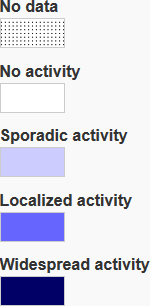FluWatch report: November 13 to November 19, 2016 (week 46)
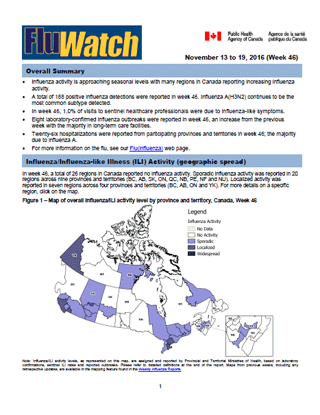
Download the alternative format
(PDF format, 773 KB, 6 pages)
Organization: Public Health Agency of Canada
Date published: 2016-11-25
Related Topics
Overall Summary
- Influenza activity is approaching seasonal levels with many regions in Canada reporting increasing influenza activity.
- A total of 188 positive influenza detections were reported in week 46. Influenza A(H3N2) continues to be the most common subtype detected.
- In week 46, 1.0% of visits to sentinel healthcare professionals were due to influenza-like symptoms.
- Eight laboratory-confirmed influenza outbreaks were reported in week 46, an increase from the previous week with the majority in long-term care facilities.
- Twenty-six hospitalizations were reported from participating provinces and territories in week 46; the majority due to influenza A.
- For more information on the flu, see our Flu(influenza) web page.
On this page
- Influenza/Influenza-like Illness (ILI) Activity (geographic spread)
- Laboratory Confirmed Influenza Detections
- Syndromic/Influenza-like Illness Surveillance
- Influenza Outbreak Surveillance
- Provincial/Territorial Influenza Hospitalizations and Deaths
- Sentinel Hospital Influenza Surveillance
- Influenza Strain Characterizations
- Antiviral Resistance
- Provincial and International Influenza Reports
- FluWatch definitions for the 2016-2017 season
Influenza/Influenza-like Illness (ILI) Activity (geographic spread)
IIn week 46, a total of 26 regions in Canada reported no influenza activity. Sporadic influenza activity was reported in 20 regions across nine provinces and territories (BC, AB, SK, ON, QC, NB, PE, NF and NU). Localized activity was reported in seven regions across four provinces and territories (BC, AB, ON and YK). For more details on a specific region, click on the map.
Figure 1 - Text Description
In week 46, a total of 26 regions in Canada reported no influenza activity. Sporadic influenza activity was reported in 20 regions across nine provinces and territories (BC, AB, SK, ON, QC, NB, PE, NF and NU). Localized activity was reported in seven regions across four provinces and territories (BC, AB, ON and YK).
Laboratory Confirmed Influenza Detections
In week 46, the percentage of tests positive for influenza remained similar to the previous week with 4.5% of tests positive for influenza. The percentage of tests positive for influenza is approaching seasonal levels. For data on other respiratory virus detections, see the Respiratory Virus Detections in Canada Report on the Public Health Agency of Canada (PHAC) website.
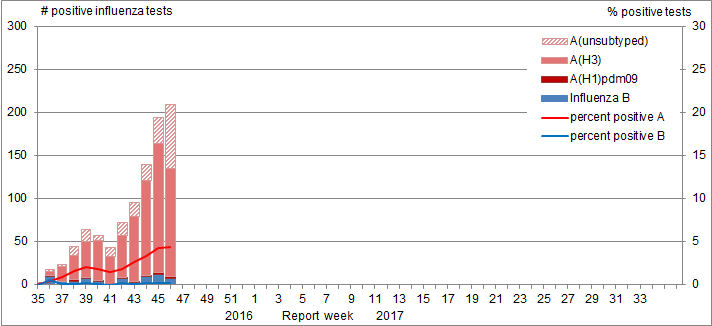
Figure 2 - Text Description
| Report Week | A(Unsubtyped) | A(H3) | A(H1)pdm09 | Influenza B |
|---|---|---|---|---|
| 35 | 0 | <5 | 0 | 0 |
| 36 | <5 | 0 | <5 | 9 |
| 37 | <5 | 17 | 0 | <5 |
| 38 | 11 | 28 | <5 | <5 |
| 39 | 14 | 41 | <5 | 7 |
| 40 | 0 | 47 | <5 | <5 |
| 41 | 10 | 31 | 0 | <5 |
| 42 | 14 | 49 | <5 | 6 |
| 43 | 16 | 76 | <5 | <5 |
| 44 | 19 | 110 | <5 | 9 |
| 45 | 31 | 150 | <5 | 11 |
| 46 | 75 | 125 | <5 | 7 |
| 47 | 0 | 0 | 0 | 0 |
| 48 | 0 | 0 | 0 | 0 |
| 49 | 0 | 0 | 0 | 0 |
| 50 | 0 | 0 | 0 | 0 |
| 51 | 0 | 0 | 0 | 0 |
| 52 | 0 | 0 | 0 | 0 |
| 1 | 0 | 0 | 0 | 0 |
| 2 | 0 | 0 | 0 | 0 |
| 3 | 0 | 0 | 0 | 0 |
| 4 | 0 | 0 | 0 | 0 |
| 5 | 0 | 0 | 0 | 0 |
| 6 | 0 | 0 | 0 | 0 |
| 7 | 0 | 0 | 0 | 0 |
| 8 | 0 | 0 | 0 | 0 |
| 9 | 0 | 0 | 0 | 0 |
| 10 | 0 | 0 | 0 | 0 |
| 11 | 0 | 0 | 0 | 0 |
| 12 | 0 | 0 | 0 | 0 |
| 13 | 0 | 0 | 0 | 0 |
| 14 | 0 | 0 | 0 | 0 |
| 15 | 0 | 0 | 0 | 0 |
| 16 | 0 | 0 | 0 | 0 |
| 17 | 0 | 0 | 0 | 0 |
| 18 | 0 | 0 | 0 | 0 |
| 19 | 0 | 0 | 0 | 0 |
| 20 | 0 | 0 | 0 | 0 |
| 21 | 0 | 0 | 0 | 0 |
| 22 | 0 | 0 | 0 | 0 |
| 23 | 0 | 0 | 0 | 0 |
| 24 | 0 | 0 | 0 | 0 |
| 25 | 0 | 0 | 0 | 0 |
| 26 | 0 | 0 | 0 | 0 |
| 27 | 0 | 0 | 0 | 0 |
| 28 | 0 | 0 | 0 | 0 |
| 29 | 0 | 0 | 0 | 0 |
| 30 | 0 | 0 | 0 | 0 |
| 31 | 0 | 0 | 0 | 0 |
| 32 | 0 | 0 | 0 | 0 |
| 33 | 0 | 0 | 0 | 0 |
| 34 | 0 | 0 | 0 | 0 |
Nationally in week 46, there were 188 positive influenza tests. BC, AB and ON accounted for the majority (85%) of influenza detections in week 46. To date, influenza A(H3N2) is the most common subtype detected, representing 73% of laboratory-confirmed cases. For more detailed weekly and cumulative influenza data, see the text descriptions for Figures 2 and 3 or the Respiratory Virus Detections in Canada Report.
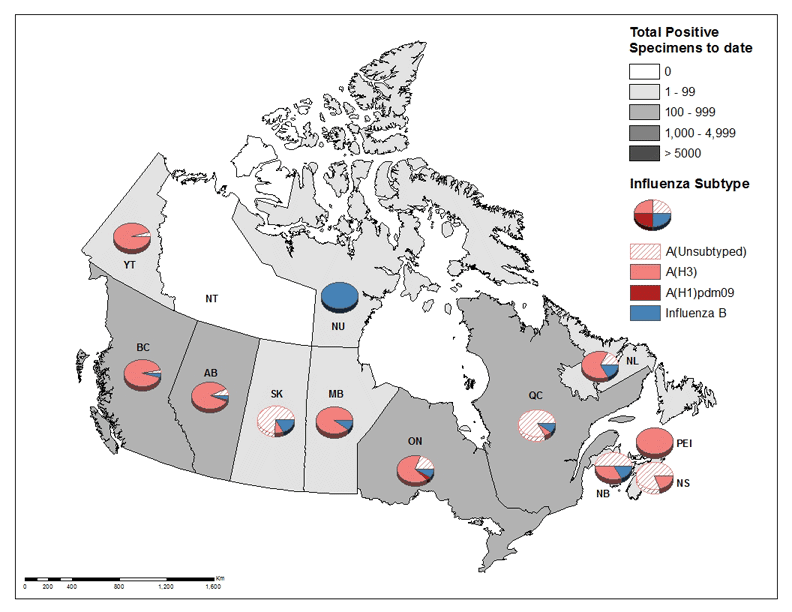
Figure 3 - Text Description
| Reporting provincesTable Figure 3 - Footnote 1 |
Weekly (October 30, 2016 to November 5, 2016) | Cumulative (August 28, 2016 to November 5, 2016) | |||||||||
|---|---|---|---|---|---|---|---|---|---|---|---|
| Influenza A | B | Influenza A | B | A & B Total |
|||||||
| A Total |
A (H1)pdm09 |
A (H3) |
ATable Figure 3 - Footnote UnS | B Total |
A Total |
A (H1)pdm09 |
A (H3) |
ATable Figure 3 - Footnote UnS | B Total |
||
| BC | 46 | 0 | 46 | 0 | 2 | 244 | 2 | 234 | 8 | 12 | 256 |
| AB | 63 | 0 | 62 | 1 | 3 | 264 | 3 | 242 | 19 | 13 | 277 |
| SK | 2 | 0 | 0 | 2 | 0 | 19 | 0 | 2 | 17 | 4 | 23 |
| MB | 1 | 0 | 1 | 0 | 0 | 9 | 0 | 9 | 0 | 1 | 10 |
| ON | 43 | 2 | 34 | 7 | 2 | 169 | 8 | 125 | 36 | 17 | 186 |
| QC | 18 | 0 | 3 | 15 | 2 | 92 | 0 | 7 | 85 | 10 | 102 |
| NB | 1 | 0 | 0 | 1 | 0 | 5 | 0 | 2 | 2 | 1 | 6 |
| NS | 1 | 0 | 0 | 1 | 0 | 5 | 0 | 1 | 3 | 0 | 5 |
| PE | 0 | 0 | 0 | 0 | 0 | 3 | 0 | 3 | 0 | 0 | 3 |
| NL | 0 | 0 | 0 | 0 | 0 | 5 | 0 | 4 | 1 | 1 | 6 |
| YT | 4 | 0 | 4 | 0 | 0 | 52 | 0 | 50 | 2 | 0 | 52 |
| NT | 0 | 0 | 0 | 0 | 0 | 0 | 0 | 0 | 0 | 0 | 0 |
| NU | 0 | 0 | 0 | 0 | 0 | 0 | 0 | 0 | 0 | 1 | 1 |
| Canada | 179 | 2 | 150 | 27 | 9 | 867 | 13 | 679 | 175 | 60 | 927 |
| PercentageTable Figure 3 - Footnote 2 | 95% | 1% | 84% | 15% | 5% | 94% | 1% | 78% | 20% | 6% | 100% |
To date this season, detailed information on age and type/subtype has been received for 826 laboratory confirmed influenza cases. Adults aged 65+ accounted for over 40% of reported influenza cases. Among cases of influenza A(H3N2), adults aged 65+ accounted for 44% of cases.
| Age groups (years) | Weekly (November 13, 2016 to November 19, 2016) | Cumulative (August 28, 2016 to November 19, 2016) | |||||||||
|---|---|---|---|---|---|---|---|---|---|---|---|
| Influenza A | B | Influenza A | B | Influenza A and B | |||||||
| A Total | A(H1) pdm09 | A(H3) | ATable 1 - Footnote UnS | Total | A Total | A(H1) pdm09 | A(H3) | ATable 1 - Footnote UnS | Total | # | |
| 0-4 | 5 | 0 | <5 | <5 | 0 | 51 | 0 | 40 | 11 | 12 | 63 |
| 5-19 | 16 | 0 | 9 | 7 | 0 | 88 | 0 | 75 | 13 | 5 | 93 |
| 20-44 | 15 | 0 | 9 | 6 | 0 | >143 | <5 | 114 | 25 | 11 | >143 |
| 45-64 | >24 | <5 | 15 | 8 | 0 | 153 | 5 | 120 | 28 | 7 | 160 |
| 65+ | 59 | 0 | 27 | 32 | 0 | >348 | <5 | 272 | 74 | 8 | >348 |
| Total | >119 | <5 | >63 | >53 | 0 | 783 | 11 | 621 | 151 | 43 | 826 |
| PercentageTable 1 - Footnote 2 | 100% | 1% | 53% | 46% | 0% | 95% | 1% | 79% | 19% | 5% | |
Syndromic/Influenza-like Illness Surveillance
Healthcare Professionals Sentinel Syndromic Surveillance
IIn week 46, 1.0% of visits to healthcare professionals were due to ILI, a decrease from the previous week.
Figure 4 - Percentage of visits for ILI reported by sentinels by report week, Canada, 2016-17
Number of Sentinels Reporting Week 46: 108
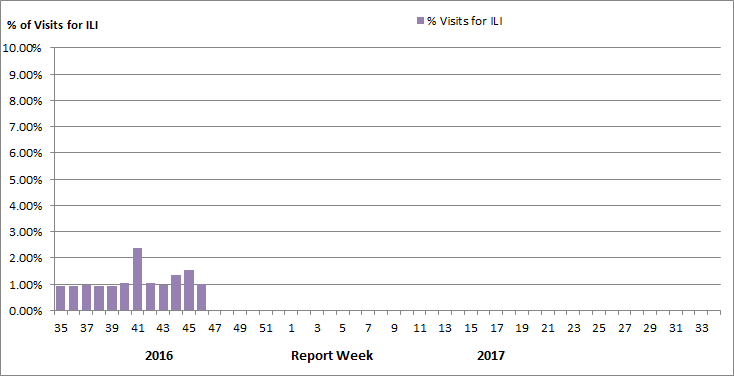 Delays in the reporting of data may cause data to change retrospectively. In BC, AB, and SK, data are compiled by a provincial sentinel surveillance program for reporting to FluWatch. Not all sentinel physicians report every week.
Delays in the reporting of data may cause data to change retrospectively. In BC, AB, and SK, data are compiled by a provincial sentinel surveillance program for reporting to FluWatch. Not all sentinel physicians report every week.
Figure 4 - Text Description
| Report week | % Visits for ILI |
|---|---|
| 35 | 0.94% |
| 36 | 0.94% |
| 37 | 0.96% |
| 38 | 0.93% |
| 39 | 0.92% |
| 40 | 1.04% |
| 41 | 2.39% |
| 42 | 1.04% |
| 43 | 0.99% |
| 44 | 1.34% |
| 45 | 1.52% |
| 46 | 1.03% |
| 47 | |
| 48 | |
| 49 | |
| 50 | |
| 51 | |
| 52 | |
| 1 | |
| 2 | |
| 3 | |
| 4 | |
| 5 | |
| 6 | |
| 7 | |
| 8 | |
| 9 | |
| 10 | |
| 11 | |
| 12 | |
| 13 | |
| 14 | |
| 15 | |
| 16 | |
| 17 | |
| 18 | |
| 19 | |
| 20 | |
| 21 | |
| 22 | |
| 23 | |
| 24 | |
| 25 | |
| 26 | |
| 27 | |
| 28 | |
| 29 | |
| 30 | |
| 31 | |
| 32 | |
| 33 | |
| 34 |
Are you a primary healthcare practitioner (General Practitioner, Nurse Practitioner or Registered Nurse) interested in becoming a FluWatch sentinel?
Please visit our Influenza Sentinel page for more details.
Influenza Outbreak Surveillance
In week 46, eight laboratory confirmed influenza outbreaks were reported. Six outbreaks were reported in long-term care (LTC) facilities and two outbreaks were reported in a hospital. Of the outbreaks with known strains or subtypes, one outbreak (in a LTC facility) was due to influenza A(H3N2) and three outbreaks (two in LTC facilities and one in a hospital) were due to influenza A(unsubtyped). An additional outbreak due to ILI was reported in a school. To date this season, 41 outbreaks have been reported and the majority (66%) have occurred in LTC facilities.
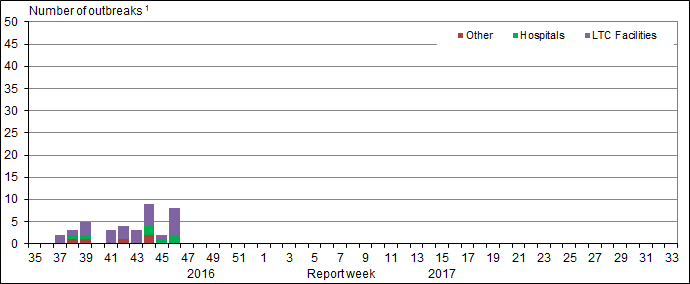
Figure 5 - Text Description
| Report week | Hospitals | Long Term Care Facilities | Other |
|---|---|---|---|
| 35 | 0 | 0 | 0 |
| 36 | 0 | 0 | 0 |
| 37 | 0 | 2 | 0 |
| 38 | 1 | 1 | 0 |
| 39 | 1 | 3 | 0 |
| 40 | 0 | 0 | 0 |
| 41 | 0 | 3 | 0 |
| 42 | 0 | 3 | 0 |
| 43 | 0 | 3 | 0 |
| 44 | 2 | 5 | 0 |
| 45 | 1 | 1 | 0 |
| 46 | 2 | 6 | 0 |
| 47 | 0 | 0 | 0 |
| 48 | 0 | 0 | 0 |
| 49 | 0 | 0 | 0 |
| 50 | 0 | 0 | 0 |
| 51 | 0 | 0 | 0 |
| 52 | 0 | 0 | 0 |
| 1 | 0 | 0 | 0 |
| 2 | 0 | 0 | 0 |
| 3 | 0 | 0 | 0 |
| 4 | 0 | 0 | 0 |
| 5 | 0 | 0 | 0 |
| 6 | 0 | 0 | 0 |
| 7 | 0 | 0 | 0 |
| 8 | 0 | 0 | 0 |
| 9 | 0 | 0 | 0 |
| 10 | 0 | 0 | 0 |
| 11 | 0 | 0 | 0 |
| 12 | 0 | 0 | 0 |
| 13 | 0 | 0 | 0 |
| 14 | 0 | 0 | 0 |
| 15 | 0 | 0 | 0 |
| 16 | 0 | 0 | 0 |
| 17 | 0 | 0 | 0 |
| 18 | 0 | 0 | 0 |
| 19 | 0 | 0 | 0 |
| 20 | 0 | 0 | 0 |
| 21 | 0 | 0 | 0 |
| 22 | 0 | 0 | 0 |
| 23 | 0 | 0 | 0 |
| 24 | 0 | 0 | 0 |
| 25 | 0 | 0 | 0 |
| 26 | 0 | 0 | 0 |
| 27 | 0 | 0 | 0 |
| 28 | 0 | 0 | 0 |
| 29 | 0 | 0 | 0 |
| 30 | 0 | 0 | 0 |
| 31 | 0 | 0 | 0 |
| 32 | 0 | 0 | 0 |
| 33 | 0 | 0 | 0 |
| 34 | 0 | 0 | 0 |
Provincial/Territorial Influenza Hospitalizations and Deaths
In week 46, 26 influenza-associated hospitalizations were reported by participating provinces and territoriesFootnote *. Influenza A accounted for 88% (n=23) of the reported hospitalizations, of which 83% (n=19) were influenza A(H3N2). Adults aged 65+ accounted for the largest proportion of hospitalizations (54%).
To date this season, 136 hospitalizations have been reported, of which 112 (81%) were due to influenza A(H3N2). Adults 65+ accounted for more than 50% of the hospitalizations. Six ICU admissions (all due to influenza A) and less than five deaths have been reported.
| Age Groups (years) | Cumulative (August 28, 2016 to November 19, 2016) | ||||||
|---|---|---|---|---|---|---|---|
| Hospitalizations | ICU Admissions | Deaths | |||||
| Influenza A Total | Influenza B Total | Total [# (%)] | Influenza A and B Total | % | Influenza A and B Total | % | |
| 0-4 | 7 | <5 | >7(–%) | 0 | –% | 0 | 0% |
| 5-19 | 10 | <5 | >10(–%) | >5 | –% | 0 | 0% |
| 20-44 | 12 | <5 | >12(–%) | 0 | –% | 0 | 0% |
| 45-64 | 19 | <5 | >19(–%) | >5 | –% | 0 | 0% |
| 65+ | 81 | <5 | >81(–%) | >5 | –% | >5 | 100% |
| Total | 129 | 7 | 136(100%) | 6 | 100% | >5 | 100% |
|
Note: Influenza-associated hospitalizations are not reported to PHAC by: BC, NU, and QC. Only hospitalizations that require intensive medical care are reported by SK. ICU admissions
– Supressed to prevent residual disclosure |
|||||||
Sentinel Hospital Influenza Surveillance
Pediatric Influenza Hospitalizations and Deaths
To date this season, 29 laboratory-confirmed influenza-associated pediatric (≤16 years of age) hospitalizations were reported by the Immunization Monitoring Program Active (IMPACT) network. Children from all age groups are being affected similarly. Influenza A accounted for 79% (n=23) of the reported hospitalizations, of which 70% (n=16) were influenza A(H3N2).
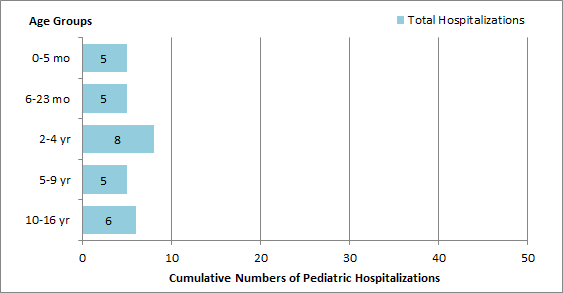
Figure 6 - Text Description
| Age Group | Total |
|---|---|
| 0-5 mo | 5 |
| 6-23 mo | 5 |
| 2-4 yr | 8 |
| 5-9 yr | 5 |
| 10-16 yr | 6 |
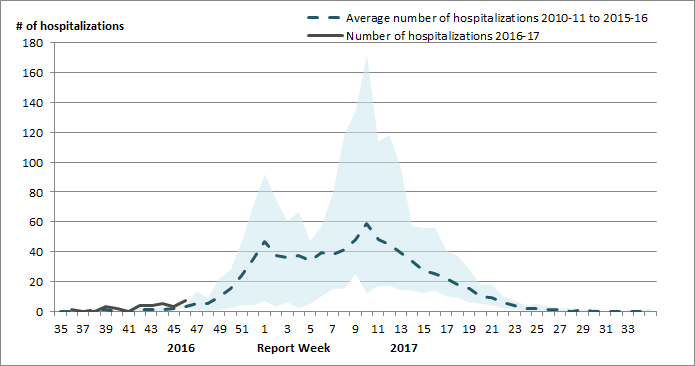
The shaded area represents the maximum and minimum number of cases reported by week from seasons 2010-11 to 2015-16
Figure 7 - Text Description
| Report week | 2016-17 | Average | Min | Max |
|---|---|---|---|---|
| 35 | 0 | 0 | 0 | 0 |
| 36 | 1 | 0 | 0 | 0 |
| 37 | 0 | 1 | 0 | 2 |
| 38 | 0 | 1 | 0 | 2 |
| 39 | 3 | 0 | 0 | 1 |
| 40 | 2 | 0 | 0 | 1 |
| 41 | 0 | 1 | 0 | 2 |
| 42 | 4 | 1 | 0 | 1 |
| 43 | 4 | 1 | 0 | 3 |
| 44 | 5 | 2 | 1 | 4 |
| 45 | 3 | 3 | 2 | 4 |
| 46 | 7 | 5 | 1 | 13 |
| 47 | #N/A | 5 | 0 | 9 |
| 48 | #N/A | 10 | 1 | 22 |
| 49 | #N/A | 15 | 2 | 28 |
| 50 | #N/A | 24 | 4 | 47 |
| 51 | #N/A | 35 | 4 | 71 |
| 52 | #N/A | 47 | 7 | 92 |
| 1 | #N/A | 37 | 3 | 75 |
| 2 | #N/A | 36 | 6 | 60 |
| 3 | #N/A | 37 | 2 | 67 |
| 4 | #N/A | 34 | 5 | 47 |
| 5 | #N/A | 39 | 10 | 57 |
| 6 | #N/A | 38 | 15 | 79 |
| 7 | #N/A | 41 | 15 | 118 |
| 8 | #N/A | 48 | 25 | 134 |
| 9 | #N/A | 59 | 12 | 172 |
| 10 | #N/A | 48 | 17 | 114 |
| 11 | #N/A | 45 | 17 | 118 |
| 12 | #N/A | 39 | 14 | 96 |
| 13 | #N/A | 33 | 14 | 57 |
| 14 | #N/A | 27 | 12 | 56 |
| 15 | #N/A | 25 | 14 | 56 |
| 16 | #N/A | 22 | 10 | 41 |
| 17 | #N/A | 18 | 9 | 37 |
| 18 | #N/A | 15 | 6 | 28 |
| 19 | #N/A | 10 | 5 | 18 |
| 20 | #N/A | 9 | 4 | 18 |
| 21 | #N/A | 6 | 2 | 10 |
| 22 | #N/A | 4 | 1 | 7 |
| 23 | #N/A | 2 | 0 | 4 |
| 24 | #N/A | 2 | 0 | 5 |
| 25 | #N/A | 1 | 0 | 3 |
| 26 | #N/A | 1 | 0 | 2 |
| 27 | #N/A | 0 | 0 | 2 |
| 28 | #N/A | 1 | 0 | 1 |
| 29 | #N/A | 0 | 0 | 2 |
| 30 | #N/A | 0 | 0 | 0 |
| 31 | #N/A | 0 | 0 | 0 |
| 32 | #N/A | 0 | 0 | 1 |
| 33 | #N/A | 0 | 0 | 0 |
| 34 | #N/A | 1 | 0 | 2 |
Adult Influenza Hospitalizations and Deaths
To date this season, less than five laboratory-confirmed influenza-associated adult (≥20 years of age) hospitalizations were reported by the Canadian Immunization Research Network (CIRN).
Note: The number of hospitalizations reported through CIRN and IMPACT represents a subset of all influenza-associated pediactric and adult hospitalizations in Canada. Delays in the reporting of data may cause data to change retrospectively.
Influenza Strain Characterizations
During the 2016-17 influenza season, the National Microbiology Laboratory (NML) has characterized 91 influenza viruses [77 A(H3N2), 5 A(H1N1), 9 influenza B].
| Strain Characterization ResultsTable 3 - Footnote 1 | Count | Description |
|---|---|---|
| Influenza A (H3N2) | ||
| Antigenically A/Hong Kong/4801/2014-like |
32 | Viruses antigenically similar to A/Hong Kong/4801/2014, the A(H3N2) component of the 2016-17 Northern Hemisphere's trivalent and quadrivalent vaccine. |
| GeneticallyTable 3 - Footnote 2 A/Hong Kong/4801/2014-like |
45 | Viruses belonging to genetic group 3C.2a. A/Hong Kong/4801/2014-like virus belongs to genetic group 3C.2a and is the influenza A(H3N2) component of the 2016-17 Northern Hemisphere's trivalent and quadrivalent vaccine. |
| Influenza A (H1N1) | ||
| A/California/7/2009-like | 5 | Viruses antigenically similar to A/California/7/2009, the A(H1N1) component of the 2016-17 Northern Hemisphere's trivalent and quadrivalent vaccine influenza vaccine. |
| Influenza B | ||
| B/Brisbane/60/2008-like (Victoria lineage) |
7 | Viruses antigenically similar to B/Brisbane/60/2008, the influenza B component of the 2016-17 Northern Hemisphere's trivalent and quadrivalent influenza vaccine |
| B/Phuket/3073/2013-like (Yamagata lineage) |
2 | Viruses antigenically similar to B/Phuket/3073/2013, the additional influenza B component of the 2016-17 Northern Hemisphere quadrivalent influenza vaccine. |
Antiviral Resistance
During the 2016-17 season, the National Microbiology Laboratory (NML) has tested 81 influenza viruses for resistance to oseltamivir and zanamivir and 39 influenza viruses for resistance to amantadine. All viruses weres sensitive to oseltamivir and zanamivir. All 39 influenza A viruses were resistant to amantadine (Table 4).
| Virus type and subtype | Oseltamivir | Zanamivir | Amantadine | |||
|---|---|---|---|---|---|---|
| # tested | # resistant (%) | # tested | # resistant (%) | # tested | # resistant (%) | |
| A (H3N2) | 67 | 0 (0%) | 67 | 0 (0%) | 36 | 36 (100%) |
| A (H1N1) | 5 | 0 (0%) | 5 | 0 (0%) | 3 | 3 (100%) |
| B | 9 | 0 (0%) | 9 | 0 (0%) | N/ATable 4 - Footnote * | N/ATable 4 - Footnote * |
| TOTAL | 81 | 0 (0%) | 81 | 0 (0%) | 39 | 39 (100%) |
Provincial and International Influenza Reports
- World Health Organization influenza update
- World Health Organization FluNet
- WHO Influenza at the human-animal interface
- Centers for Disease Control and Prevention seasonal influenza report
- European Centre for Disease Prevention and Control - epidemiological data
- South Africa Influenza surveillance report
- New Zealand Public Health Surveillance
- Australia Influenza Report
- Pan-American Health Organization Influenza Situation Report
- Alberta Health - Influenza Surveillance Report
- BC - Centre for Disease Control (BCCDC) - Influenza Surveillance
- New Brunswick - Influenza Surveillance Reports
- Newfoundland and Labrador - Surveillance and Disease Reports
- Nova Scotia - Flu Information
- Public Health Ontario - Ontario Respiratory Pathogen Bulletin
- Quebec - Système de surveillance de la grippe
- Manitoba - Epidemiology and Surveillance - Influenza Reports
- Saskatchewan - influenza Reports
- PEI - Influenza Summary
FluWatch definitions for the 2016-2017 season
Abbreviations: Newfoundland/Labrador (NL), Prince Edward Island (PE), New Brunswick (NB), Nova Scotia (NS), Quebec (QC), Ontario (ON), Manitoba (MB), Saskatchewan (SK), Alberta (AB), British Columbia (BC), Yukon (YT), Northwest Territories (NT), Nunavut (NU).
Influenza-like-illness (ILI): Acute onset of respiratory illness with fever and cough and with one or more of the following - sore throat, arthralgia, myalgia, or prostration which is likely due to influenza. In children under 5, gastrointestinal symptoms may also be present. In patients under 5 or 65 and older, fever may not be prominent.
ILI/Influenza outbreaks
Note: it is recommended that ILI school outbreaks be laboratory confirmed at the beginning of influenza season as it may be the first indication of community transmission in an area.
Note that reporting of outbreaks of influenza/ILI from different types of facilities differs between jurisdictions.
Influenza/ILI activity level
1 = No activity: no laboratory-confirmed influenza detections in the reporting week, however, sporadically occurring ILI may be reported
2 = Sporadic: sporadically occurring ILI and lab confirmed influenza detection(s) with no outbreaks detected within the influenza surveillance region Footnote †
3 = Localized:
- evidence of increased ILIFootnote * and
- lab confirmed influenza detection(s) together with
- outbreaks in schools, hospitals, residential institutions and/or other types of facilities occurring in less than 50% of the influenza surveillance regionFootnote †
4 = Widespread:
- evidence of increased ILIFootnote * and
- lab confirmed influenza detection(s) together with
- outbreaks in schools, hospitals, residential institutions and/or other types of facilities occurring in greater than or equal to 50% of the influenza surveillance regionFootnote †
Note: ILI data may be reported through sentinel physicians, emergency room visits or health line telephone calls.

